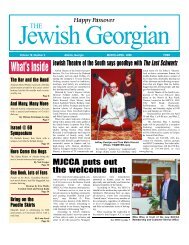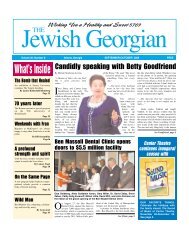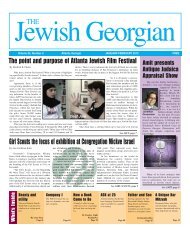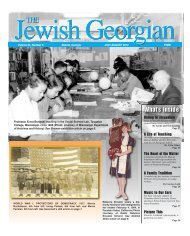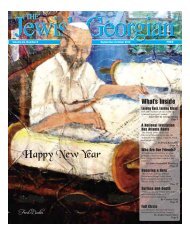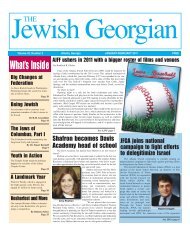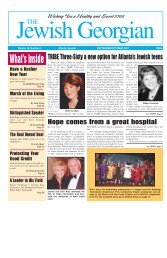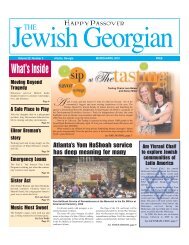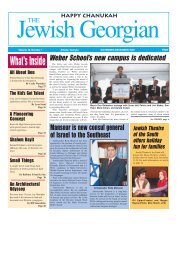Happy Chanukah - The Jewish Georgian
Happy Chanukah - The Jewish Georgian
Happy Chanukah - The Jewish Georgian
You also want an ePaper? Increase the reach of your titles
YUMPU automatically turns print PDFs into web optimized ePapers that Google loves.
November-December 2011 THE JEWISH GEORGIAN Page 43<br />
Israeli folk dancing is becoming an Atlanta tradition<br />
By Celia Gilner<br />
Who is that graceful dancer with the<br />
long strides and clearly defined movements,<br />
described as “having youthful enthusiasm<br />
that infects everyone around you”? It is<br />
Meliss Jakubovic Bachar.<br />
FROM GENERATION<br />
TO GENERATION<br />
Meliss began dancing as a seven-yearold,<br />
when she accompanied her mother,<br />
Jacki Jacoby Smith, to her Israeli folk dance<br />
sessions. She still speaks with frustration<br />
about the year without Israeli dancing, when<br />
her mother broke her toe, and Meliss was too<br />
young to drive.<br />
Meliss enjoyed the forty- to sixty-yearolds<br />
in her dance classes as a teen but was<br />
unsuccessful in getting her young friends<br />
involved. She was a talented and eager student.<br />
As a seventeen-year-old, Meliss<br />
became the youngest Israeli folk dance<br />
instructor in the United States.<br />
Israeli folk dance session (photo:<br />
Leon Balaban)<br />
Meliss graduated from <strong>The</strong> Epstein<br />
School in 1996, and, in the tradition of l’dor<br />
v’dor, she went back to Epstein to teach<br />
Israeli dancing, which she has done for the<br />
past twelve years. Meliss also teaches at<br />
most of the <strong>Jewish</strong> day schools in Atlanta<br />
and at many simchas, including bar and bat<br />
mitzvah parties.<br />
Her passion to have younger participants<br />
perform was fulfilled when she founded<br />
the Atlanta-based high school performing<br />
group Nitzanim (Hebrew for flower buds).<br />
<strong>The</strong>re are now fourteen girls in Nitzanim.<br />
Eleven have returned from last year, and<br />
three have been in Nitzanim for all four years<br />
of high school. <strong>The</strong> dance troupe performed<br />
on August 14, 2011, at the World Congress<br />
Center. For seven years, Nitzanim has been<br />
the only Israeli dance group from the South<br />
to perform in the Israeli Folk Dance Festival<br />
of Boston.<br />
Nitzanim performing at the Americans<br />
United with Israel rally (photo: Cohen<br />
Photographic Art)<br />
Meliss’s very first dance teacher, Debbie<br />
Kroll, has two daughters, Yaz and Lital, who<br />
joined Nitzanim when they were in high<br />
school and continue to dance at the<br />
Wednesday dance session for adults. Yaz<br />
taught dance at Camp Barney Medintz and<br />
currently leads Israeli dance sessions at her<br />
college. Like Yaz, many former members of<br />
Nitzanim have gone on to teach Israeli folk<br />
dancing. Meliss is proud of her son Shai’s<br />
dance performances; she has promised he<br />
can attend the Wednesday adult dance session<br />
when he turns seven and hopes he will<br />
become her dance partner. Along with his<br />
younger brother, Ilan, Shai is immersed in<br />
Israeli folk songs and dances daily.<br />
A PORTAL TO JUDAISM AND ISRAEL<br />
A major goal of Meliss’s organization,<br />
Rikud Atlanta, is to create excitement about<br />
Israeli folk dancing, which enhances her students’<br />
<strong>Jewish</strong> identity and connection to<br />
Israel. Sandra Cuttler, one of the dancers,<br />
describes it as a “portal to Judaism through<br />
dance.” She finds it “invigorating, life<br />
enriching, and constantly evolving. I’m<br />
praying with my feet.”<br />
Israeli dancing provides a space and<br />
time to let off steam. Meliss notices that she<br />
sometimes dances her best after an especially<br />
stressful day.<br />
Israeli folk dancing (photo: Leon<br />
Balaban)<br />
GETTING INVOLVED<br />
Meliss teaches adult Israeli dance classes<br />
at B’nai Torah, where she gratefully<br />
acknowledges she has “found a home with a<br />
wooden dance floor.” <strong>The</strong> Wednesday night<br />
dance sessions include teenagers and adults<br />
from as far away as Athens, with a wide<br />
range of ages up to an 86-year-old woman<br />
who has danced for forty years.<br />
Israelis who never danced in Israel and<br />
others not affiliated with a synagogue find<br />
their way to the dance sessions. It becomes a<br />
way for them to connect: to Judaism with<br />
lyrics from the Torah, to the <strong>Jewish</strong> community,<br />
to <strong>Jewish</strong> holidays and events in Israel<br />
expressed in the songs and dances Meliss<br />
chooses to celebrate at appropriate times.<br />
Every Wednesday, a 6:30-7:00 p.m.<br />
beginner’s session and a 7:00-7:40 p.m.<br />
intermediate session are taught by Avital<br />
Landman, followed by advanced circle and<br />
line dances from 7:40-9:30 p.m. and an intermediate-to-advanced<br />
couples session from<br />
9:30-10:00 p.m. with Meliss. Israeli folk<br />
dancers from all over the world who visit<br />
Atlanta often show up at the Wednesday<br />
night sessions at B’nai Torah. Participants<br />
pay per session and can come any time.<br />
When asked why people keep returning<br />
to her dance sessions, Meliss cites her<br />
emphasis on tailoring classes to each age<br />
group and teaching via clear movement and<br />
instruction. She is able to see what each individual<br />
needs by moving around the circle<br />
and standing in front of the person asking a<br />
question. Meliss learned to speak modern<br />
Hebrew by volunteering to translate songs<br />
for hebrewsongs.com. She can sing every<br />
single song as she dances and calls steps by<br />
name, rhythm, and counts.<br />
She participated in a questionnaire from<br />
Mona Goldstein, a friend and dance instructor<br />
in Washington, D.C., who is writing a<br />
dance instructors’ manual, and she is anxious<br />
to read it. To pique her students’ interest, she<br />
has theme nights when she serves food from<br />
a particular country whose dance steps have<br />
been incorporated into Israeli folk dancing.<br />
One night, she had food from Yemen,<br />
Yemenite decorations, and an artist who<br />
painted henna tattoos. For Persian night, she<br />
surprised her students by having a belly<br />
dancer teach, rather than perform for them.<br />
FOR EVERY SONG A DANCE<br />
From its socialistic roots in pre-state<br />
Israel, where the pioneers of the 1930s and<br />
1940s danced barefoot on the ground, holding<br />
hands or clasping arms, Israeli folk dancing<br />
has become a worldwide phenomenon.<br />
Dance was emphasized as a way to promote<br />
a distinctly Israeli culture and to unite a<br />
diverse multi-language immigrant population.<br />
Today, when a popular Israeli song<br />
comes out, a choreographer can register with<br />
the Irgun Hamadrichim and create a dance<br />
for it. It becomes the official dance for that<br />
song. <strong>The</strong>re has been an explosion of creativity,<br />
and today there are over 7,000 choreographed<br />
Israeli dances. With today’s technology,<br />
a dance can be disseminated through<br />
youtube, websites, DVDs, and CDs very<br />
quickly in thirty-two countries. As soon as a<br />
song is played, each person is able to know<br />
the dance for that particular song.<br />
Dance camps and dance festivals are<br />
ways to connect with other Israeli folk<br />
dancers. Israeli culture is brought to the<br />
world in a positive, healthy, and social way.<br />
<strong>The</strong>se events have become so popular<br />
that dancers plan their vacations around the<br />
dance sessions in a particular city. In Tel<br />
Aviv, Israel, for example, on Thursday<br />
nights, famed choreographer Gadi Bitton<br />
attracts 1,500 people. Meliss’ “all-time<br />
favorite” is Beit Dani, in Tel Aviv, on Sunday<br />
nights, with Dudu Barzilay. On July 12-14,<br />
2011, the yearly Israeli Dance Festival, in<br />
Karmiel, attracted the best Israeli dance<br />
instructors and 10,000 dancers from all over<br />
the world.<br />
Meliss Jakubovic Bachar and Dudu<br />
Barzilay (photo: Alex Huber<br />
Professional Photography)<br />
To read more and get involved in Israeli<br />
folk dancing, check out Meliss’ website,<br />
www.rikudatlanta.com; the Israeli Folk<br />
Dancers Association website,<br />
www.harokdim.org/indexENG.php;<br />
www.rokdim.co.il; and<br />
www.israelidances.com.



